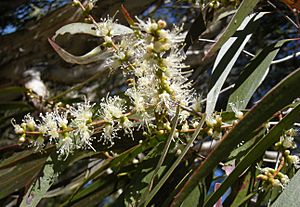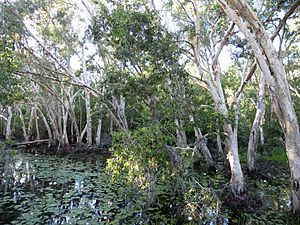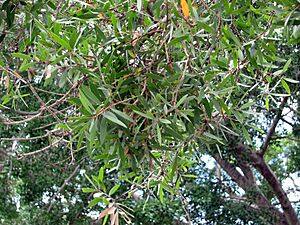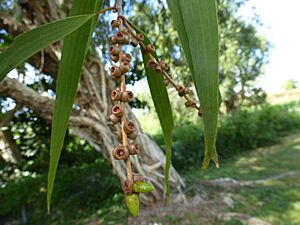Long-leaved paperbark facts for kids
Quick facts for kids Long-leaved paperbark |
|
|---|---|
 |
|
| Scientific classification | |
| Genus: |
Melaleuca
|
| Species: |
leucadendra
|
| Synonyms | |
|
List
Cajuputi leucadendron (L.) Rusby ex A.Lyons
Leptospermum leucodendron (L.) J.R.Forst. & G.Forst. Melaleuca latifolia Raeusch. nom. inval., nom. nud. Melaleuca leucadendra (L.) L.f. leucadendra Melaleuca leucadendra (L.) L. var. leucadendra Melaleuca leucadendra var. mimosoides (A.Cunn. ex Schauer) Cheel Melaleuca leucadendron L.f. orth. var. Melaleuca leucadendron L.f. var. leucadendron orth. var. Melaleuca leucadendron var. mimosoides Cheel orth. var. Melaleuca mimosoides A.Cunn. ex Schauer Metrosideros coriacea Salisb. Myrtus leucadendra L. |
|
The weeping paperbark (scientific name: Melaleuca leucadendra) is a type of plant in the Myrtaceae family. This family also includes the myrtle tree. You can find this tree across northern Australia, Southeast Asia, New Guinea, and the Torres Strait Islands.
This tree can grow very tall, sometimes over 20 meters (about 65 feet). It has a thick, white, papery bark on its trunk. Its thinner branches often hang down, making it look like it's "weeping." The weeping paperbark can flower almost any time of the year. People often plant it in parks and along roads because it's a beautiful tree. It was the first Melaleuca tree ever described by scientists. It was first found in Indonesia.
Contents
About the Weeping Paperbark
The weeping paperbark, or Melaleuca leucadendra, is a large tree. It usually grows to about 20 meters (65 feet) tall, but can sometimes be taller. Its bark is thick and feels like paper. It is usually white, but can also be pink or cream-colored. The branches often droop downwards.
When the leaves and young branches first grow, they are covered with tiny, soft white hairs. As they get older, they become smooth (this is called glabrous). The leaves grow one after another along the stem. They are about 7.5 to 27 centimeters (3 to 11 inches) long and 0.6 to 4 centimeters (0.2 to 1.6 inches) wide. They are flat and shaped like a narrow egg or a spear, getting thinner towards the tip. Each leaf has 5 to 9 long veins running through it. The leaves are often curved or shaped like a sickle.
The flowers of the weeping paperbark are cream, white, or greenish-white. They grow in spikes at the ends of branches. These branches keep growing even after the flowers bloom. Sometimes, flowers also grow on the sides of branches or where leaves join the stem. Each flower spike is about 3.5 centimeters (1.4 inches) wide and up to 8 centimeters (3.1 inches) long. Each spike has 7 to 22 groups of flowers, with three flowers in each group.
The petals of the flowers are about 3 to 4 millimeters (0.12 to 0.16 inches) wide. They fall off soon after the flower opens. Inside the flower, there are five groups of stamens (the parts that make pollen). Each group has 5 to 12 stamens. This tree can flower at any time of the year. After flowering, it produces woody fruits. These fruits are like small capsules, about 3.9 to 4.9 millimeters (0.15 to 0.19 inches) long. They grow in loose clusters along the stems.



How It Got Its Name
The weeping paperbark was first officially described in 1762 by a famous scientist named Carl Linnaeus. He first called it Myrtus leucadendra. Linnaeus used notes from another scientist, Georg Eberhard Rumphius, who had described the plant in 1741. At that time, the modern way of classifying plants didn't exist yet.
Later, Linnaeus realized this tree was very different from other Myrtus plants. So, he created a new group, or genus, called Melaleuca just for this tree. This means Melaleuca leucadendra was the very first Melaleuca tree to be formally described. This new description was published in 1767. Even though most Melaleuca trees are found in Australia, the first example (called a type specimen) came from Indonesia.
The second part of its scientific name, leucadendra, comes from two ancient Greek words. "Leukós" means "white," and "déndron" means "tree." This name refers to the white bark of the tree.
Melaleuca leucadendra looks a lot like other paperbark trees. Some of these are Melaleuca cajuputi, Melaleuca quinquenervia, Melaleuca linariifolia, and Melaleuca viridiflora. People sometimes call all of these trees "cajuput" or "cajeput." The word "cajuput" is an English word for an oil that comes from the leaves of Melaleuca cajuputi. This word might have come from "kayu putih," which is the Indonesian name for the tree. In the Malay language, the paperbark tree is called "gelam." This name might be where the Kampong Glam area in Singapore got its name.
Where It Grows
This Melaleuca tree grows in many places in northern Western Australia, the Northern Territory, and Queensland. In Queensland, it grows as far south as Shoalwater Bay. You can also find it in New Guinea and Indonesia. It likes to grow in forests near rivers and streams, and it can grow in different types of soil.
How People Use It
Traditional Uses
Aboriginal people used the bark from this tree in many ways. They would tie strips of bark to frames made of Dodonaea branches to build waterproof huts. The bark was also used to wrap food before cooking it in an underground oven called a kap mari. They even used the bark to wrap the bodies of their dead. Very large trees provided bark for making bark canoes. Crushed leaves were used to help with breathing problems, and the flowers were used to make a sweet drink.
Growing in Gardens
People often plant this type of Melaleuca in parks and along streets in warm, tropical places. You can see it in cities like Brisbane and even as far south as Sydney. It grows best in sunny spots. It can also grow well in poor soil that has a lot of water. It has even been used as a street tree in Hong Kong.
Special Oils
Different types of special oils, called essential oils, can be taken from this tree. The kind of oil depends on where the tree grows. Two common types of these oils are based on chemicals called methyl eugenol and E-methyl isoeugenol.
Timber Uses
The wood from Melaleuca leucadendra can be used for building things. In Vietnam, for example, it is used for poles, piles (strong posts driven into the ground), and woodchips.
See also
 In Spanish: Melaleuca leucadendra para niños
In Spanish: Melaleuca leucadendra para niños


